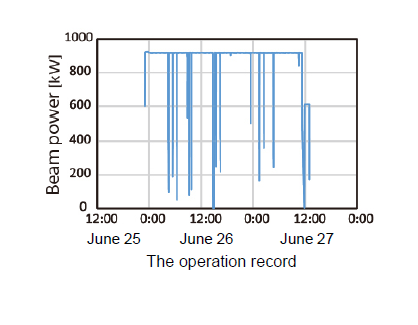J-PARC News June 2020 (Issue #182)
■ Hideaki Hotchi Receives the Gersh Budker Prize in the Accelerator Field (May 14, Caen, France)
Hideaki Hotchi of the J-PARC Center Accelerator Division (JAEA Principal Researcher) received the Gersh Budker Prize from the European Physical Society/International Particle Accelerator Conference (IPAC'20) in May 2020. This time, IPAC'20 was held remotely and Dr. Hotchi gave a commemorative lecture online. Budker is a prominent Russian accelerator physicist who first developed the electron cooling method, and the award bears his name to honor the physicist. It is given to those who have made outstanding achievements in the accelerator field. Dr. Hotchi began participating in the project during the design and construction stage of the J-PARC 3-GeV Rapid Cycling Synchrotron (RCS), and have consistently directed the beam commissioning since the beam operation started in 2007. He was highly commended for achieving 1 MW beam operation at unprecedented low levels of beam loss through his beam dynamics studies with accurate beam simulations. His work was recognized as significant achievement that will build the foundation for the development of the high-intensity proton synchrotron in the future.
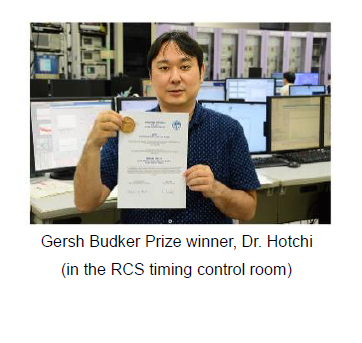
■ Ryo Kitamura Receives the Young Scientist Award from the Physical Society of Japan (March, 2020)
Ryo Kitamura (Accelerator Section I) received the Young Scientist Award*1 for his doctoral dissertation, "Demonstration of muon acceleration with Radio-Frequency Quadrupole linac" (September 2018), in the Beam Physics category of the Physical Society of Japan. A research group preparing for the J-PARC muon g-2/EDM experiment*2, which Dr. Kitamura joined, successfully demonstrated the acceleration of muonium negative ions (Mu-) almost at rest to 90 keV, using RFQ at the MLF muon beamline in October 2017 (for the first time in the world). His paper summarized the research results. This achievement is one of the major steps toward the run of the J-PARC muon g-2/EDM experiment and is expected to greatly advance epoch-making research, such as performing non-destructive measurement of the inside of the materials.
*1 The Physical Society of Japan has established the Young Scientist Award in 19 research fields to encourage the research of excellent young researchers who will lead the future of physics and energize academic society.
*2 The experiment focuses on measuring the anomalous magnetic moment (g-2) and electric dipole moment (EDM) of the muon with the world’s highest accuracy.
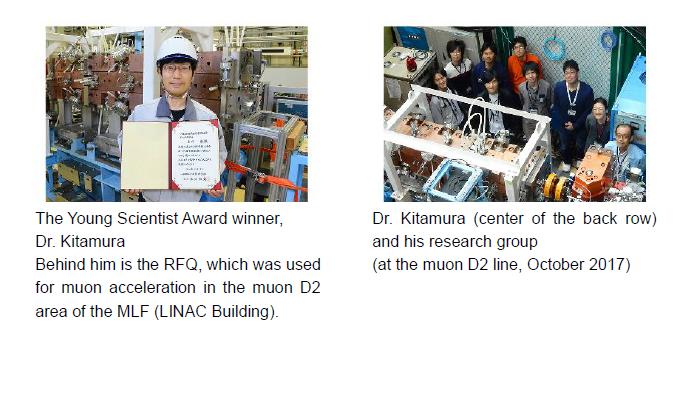
■ Detected Metallic Lithium Deposition on Electrode of a Lithium-ion Battery Using Muon -Application of Non-destructive Elemental Analysis by Muonic X-rays- (June 16, Press Release)
Depending on working conditions under which the battery is used, lithium ions, which are the transporter of electricity in a lithium-ion battery, are reduced and deposited as metal. This may lead to short circuits between electrodes, thermal reaction with the electrolyte, and even results in battery capacity reduction. Therefore, it is essential to check for metallic lithium deposition.
KEK's Institute of Materials Structure Science, Toyota Central R&D Labs, and other organizations formed a research group. The group succeeded in detecting metallic lithium deposits on the graphite anode prepared in a lithium battery by using the D-line’s negative muon beam in J-PARC's muon science facility (MUSE) of the Materials and Life Science Experimental Facility (MLF). If the battery’s charging status is known, the amount of lithium stored in the electrodes in the state of ions can be found out. A portion of the ions reduced to be deposited as metallic lithium. After irradiating with a negative muon, the intensity of all muonic X-rays emitted by lithium was obtained. Thus, it became possible to estimate the amount of metallic lithium deposition by subtracting the known amount of lithium stored in the electrode. The important point is that non-destructive measurements were performed on the electrodes that covered with a thin laminated sheet taking advantage of the high transparency of muons. In addition, the position (depth) where metallic lithium is deposited in the depth direction of the electrode can be detected by controlling the penetration depth into the electrode by changing the momentum of the negative muon.
This achievement was made because a high-intensity negative muon beam has been obtained in J-PARC. Furthermore, a dramatic increase of the muon intensity in the future and an improved detector will allow the measurement of muonic X-rays in real-time while charging and discharging batteries. The negative muons in J-PARC will contribute more and more to the research for improving the safety of lithium-ion batteries and the deterioration of the battery capacity.

■ University of Tokyo and KEK sign MoU to promote Hyper-Kamiokande project (May 25)
In May, the University of Tokyo (President Makoto Gonokami) and High Energy Accelerator Research Organization (KEK) (Director General Masanori Yamauchi) signed a memorandum of understanding (MoU) regarding the promotion of the Hyper-Kamiokande project in light of the commencement of the project. This project aims to elucidate the origin of matter in the universe and the unified theory of elementary particles. A new water tank detector will be constructed, which has an effective volume of 8.4 times larger than that of the Super-Kamiokande detector, which is a neutrino detector used for the current ongoing T2K (Tokai to Kamioka) experiment. Use of the detector and a high-intensity neutrino beam produced by an upgraded J-PARC accelerator will dramatically expedite the experiment. The construction budget was approved by the Japanese Government and the project was officially launched aiming to begin operation in 2027 as an international collaborative experiment with co-researchers in Japan and abroad.
■ Held 2020 General Assembly Meeting of MLF (June 9, J-PARC Research Building)
On June 9, a General Assembly Meeting of the J-PARC Materials and Life Science Experimental Facility (MLF) was held remotely on zoom. About 140 people participated, including the J-PARC Center, Comprehensive Research Organization for Science and Society (CROSS) Neutron Science and Technology Center, Ibaraki Prefecture, and the universities in charge of the experimental equipment. Following the greeting from the J-PARC Director Naohito Saito, Toshiya Otomo, who assumed the MLF Division Head in April, described the division's policy and the new organizational structure for this year. Section leaders from the Neutron Source, Neutron Science, Muon Science, Technology Development, and Neutron Instrumentation sections gave reports on the current situations and the action policies, as well as an introduction of new staff members. In addition, Nobuhiro Kosugi, director of the Institute of Materials Structure Science, KEK, Mitsuhiro Shibayama, who assumed the director of CROSS Neutron Science and Technology Center in June, Hironori Kodama, Technical Director of the Ibaraki Prefectural government, and Takamitsu Kohzuma, director of Frontier Research Center for Applied Atomic Sciences, Ibaraki University (iFRC) reported the current status of each organization.
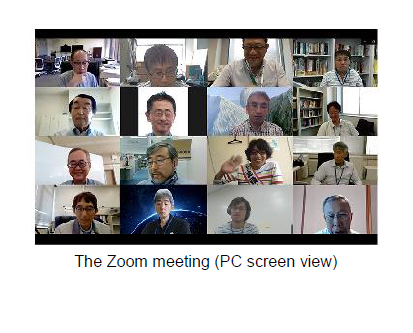
■ 2020 "Saruhashi Award" Winner Atsuko Ichikawa Meets with Tokai Village Mayor Osamu Yamada (June 15, Tokai Village Office)
On May 23, Kyoto University Associate Professor Atsuko Ichikawa, (resident of Tokai Village), who won the 40th Saruhashi Award from the Association for the Bright Future of Women Scientists, was invited to meet with Mayor Osamu Yamada and Deputy Mayor Hiroyasu Hagiya at the Tokai Village Office. Ichikawa, who was wearing a T-shirt with a T2K experiment logo, was welcomed by a lot of warm applause from the staff on the floor of the Mayor's office. She talked about the current status of the neutrino research (T2K experiment) for which she received the award and the Hyper-Kamiokande project, which is planned to start in 2027, as well as her life having to balance two jobs: teaching weekly at Kyoto University and conducting experiments at J-PARC. She also explained how she was surprised to receive such publicity after receiving the award: featured in a newspaper and being interviewed. But, she said that she was happy to be able to work on research of her interest. The village mayor said that J-PARC is the pride of Tokai Village, and that how wonderful it is that female researchers were successful at the facility. He was also excited that more achievements by female researchers are coming in the future. This meeting will be featured in the Newsletter Tokai, scheduled to be published on July 10.
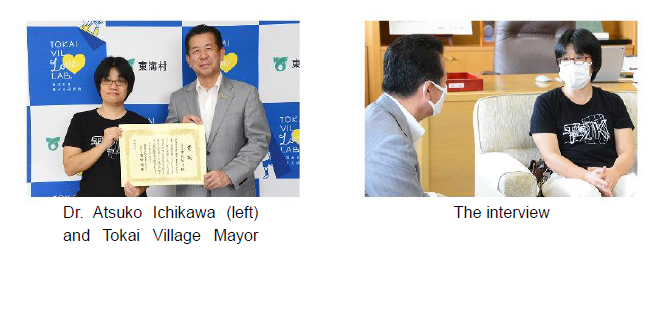
■ Hadron Experimental Facility Passes Facility Inspection associated with Facility Remodeling (June 24)
At the Hadron Experimental Facility, researchers have been conducting experiments using secondary particles, such as K mesons, generated by the protons of the high-intensity primary beamline called the A line from the beginning of the facility operation in February 2009 until last year. In addition, in order to start a new experiment using a primary proton beam, etc., a new primary beamline (B line), that diverts protons from the A line in the switchyard, has been installed. This B line has just been completed, and a registered inspection agency inspected the facility associated with facility remodeling. It passed the inspection on June 24 and its operation commenced on June 25.
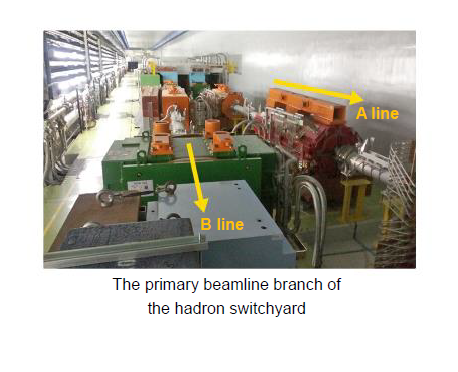
■ 1 MW Beam Operation for Users held for 3 Days at MLF (June 25 – 27, J-PARC)
Currently, the MLF is providing beams stably at 600 kW. To achieve the final goal, which is to provide stable operation at 1 MW, we have carried out 1 MW test operations several times so far. In July last year, we provided 1 MW beam for 10 and a half hours as a test operation. In this year, the MLF conducted 1 MW beam operation for users from June 25 to 27. During this operation, the neutron and muon source group checked the stability of the operation and collected the data of the pressure wave in the mercury target, the cooling performance of the cryogenic hydrogen facility, the temperature characteristics of the muon rotary target, and so on. In addition, users and instrumental groups carried out experiments by using high intensity neutron and muon beams, which include the performance tests of the instruments. The data and experiences obtained with this 1 MW operation will be used to achieve safe and stable 1 MW operation.
